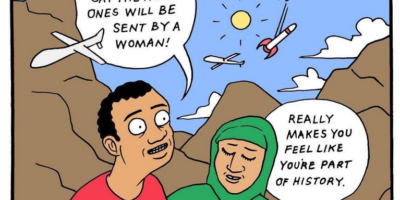A decent homage, but not exactly an Easter miracle
By Stan Heaton
If you don’t know who Ray Harryhausen is, then get on imdb.com immediately and look him up. Mr. Harryhausen is a pioneer in special visual effects. His stop-motion animation and creature creations have inspired science fiction filmmakers from Steven Spielberg and John Landis to George Lucas and Peter Jackson (see The Sci-Fi Boys [2006]). Using lumps of clay, plastic, and a 16mm camera, Harryhausen was able to deliver his vivid imagination to the movie screen in its unbound form, not shackled by the constraints of scale or film or reality. Though he directed many pictures, his legacy will be his visual effects work in classics like The 7th Voyage of Sinbad (1958), Jason and the Argonauts (1963), One Million Years B.C. (1963), and Clash of the Titans (1981).
In these films, characters often confront the most impossible of beasts. In Jason and the Argonauts, Harryhausen created a group of skeleton warriors, summoned from the earth to fight Jason and his soldiers. The entire scene is a wonder. Blades from the skeletons clang against those of the human actors, and the Argonauts jump over swords as the skeletons swipe at them; it’s downright impressive for 1963. This is the sort of movie that my dad looks back on with a great deal of nostalgia for his childhood adventure days, and he has Ray Harryhausen to thank for it.
By 1981, when the original Clash of the Titans was released, Harryhausen’s brand of special effects was old hat. Most of America was ready to trade the grotesque clay monsters and sleek alien spacecraft for more realistic visual splendors. Stanley Kubrick’s 2001: A Space Odyssey (1968) had ushered in a new wave of science fiction, with its attention to the mechanical details of spacecrafts and its immense outer space vistas. Other filmmakers, George Lucas and Ridley Scott among them, followed Kubrick’s lead and began their ventures into computer-generated imagery. Since then, computer graphics have dominated the movie business, but there will always be a unique place reserved for stop-motion films (as The Fantastic Mr. Fox [2009] has shown us).
Despite its antiquated graphics, the original Clash maintained a large fan following, and like many cult-classics, someone decided to remake it. The new Clash of the Titans follows Perseus (Sam Worthington) on his quest for revenge against Hades (Ralph Fiennes) for the murder of his earthly family. Along the way, Perseus learns of his godly heritage, meets a few loyal soldiers, and battles a menagerie of mythological beasts. It’s predictable, but people aren’t going to see this movie in the hopes of a revolutionary plot. The movie is billed as an action flick through-and-through, and it delivers.
Worthington’s chiseled jawline and good acting skills make him a formidable action star. After performing well in 2009 with roles in Terminator: Salvation and Avatar, it’s no surprise that he was selected to play Perseus in Clash. His monologues in the film are cheesy in the most Hollywood of ways, but he delivers them as well as anybody can expect. Liam Neeson and Ralph Fiennnes, who play Zeus and Hades, respectively, bring some acting weight to the film, but nothing noteworthy.
In the true spirit of the original, the real stars of this latest Clash are the monsters. The enormous desert scorpions, mystical jinn, conniving witches, and bat-like harpies all round out a world full of strangeness that, I can only imagine, should captivate the teen boy demographic. Medusa, the horrible and beautiful Gorgon, is poorly done. Her face and body shine with the lifelessness of computer animation. I’m not exactly sure how to describe bad CGI; I just know that it looks too fake for me to enjoy. Maybe “stupid” would be a good word. Yes. Medusa looks stupid. This error is partially made up for by the Kraken, a sea-beast that destroyed the Titans in the war between the gods. The Kraken takes center stage in the movie’s trailer, and most of the film narrative is a countdown to its release. The scene in which this tentacled monster ravages the coastal city of Argos is clearly meant to be a moment of visual awe that harkens back to Harryhausen’s prime, but much like the original Clash, it seems a bit tired.
Beyond the graphics: stories of life and death
Toy Story came out in 1995, and the number of advances in computer graphics that have made films significantly different for a viewing audience since then could probably be counted on one hand. Special effects alone just can’t carry a film anymore. Sure, Avatar made gobs of cash, and its use of 3D enhanced graphics had a lot to do with that, but it had a lot of other things going on. I’m not sure the new Clash does.
The stories in both Clash of the Titans movies vary greatly from the myth of Perseus as told by Ovid in his Metamorphoses. The most significant difference in this latest rendition is Perseus’s utter denial of the need for gods. In Book 4 of Metamorphoses and in the 1981 Clash, Perseus accepts many gifts from several gods in his quests, and he later honors those gods with sacrifices and spoils. The 2010 Perseus wants nothing to do with the gods. He even plans to destroy Hades out of revenge. I find it strange that the filmmakers would think this to be a viable narrative in American culture. Have we already killed our gods and replaced them with dead presidents? with machines? with ourselves? Or have we simply lost the language skills necessary to interpret our own spiritual metaphors?
As I sat in the dark theater, sipping my expensive Mr. Pibb and thinking about Easter, I couldn’t help but draw the connections between Perseus and Jesus. They are both the offspring of a god and a virgin mother, both die and are resurrected, and both choose to serve mankind while on earth. This is where the new Perseus falters. Joseph Campbell, the famed comparative mythologist, shows us that, throughout time and across cultures, myths are meant to bring people to the recognition that transcendence exists across all life. Death, Campbell points out, is a vital part of the transcendence because it allows new life to begin (see The Power of Myth [1988]).
Jesus’s death on the cross is also his spiritual birth into the plane of transcendence. The Buddha goes through a similar transformation under the bodhi tree. In the Clash of the Titans, Perseus defeats death and rejects Zeus’s offer to join him on Olympus. In his rejection of death and his insistence on remaining human, Perseus waivers from the hero’s path; yet, he lives happily ever after. I’m troubled by this deviation and worried that our culture is losing its ability to understand the metaphors of myth, though I’m certain that most people won’t care about either of these.
No, most people will only care to see the Kraken, without ever considering what it might represent.



Leave a Reply